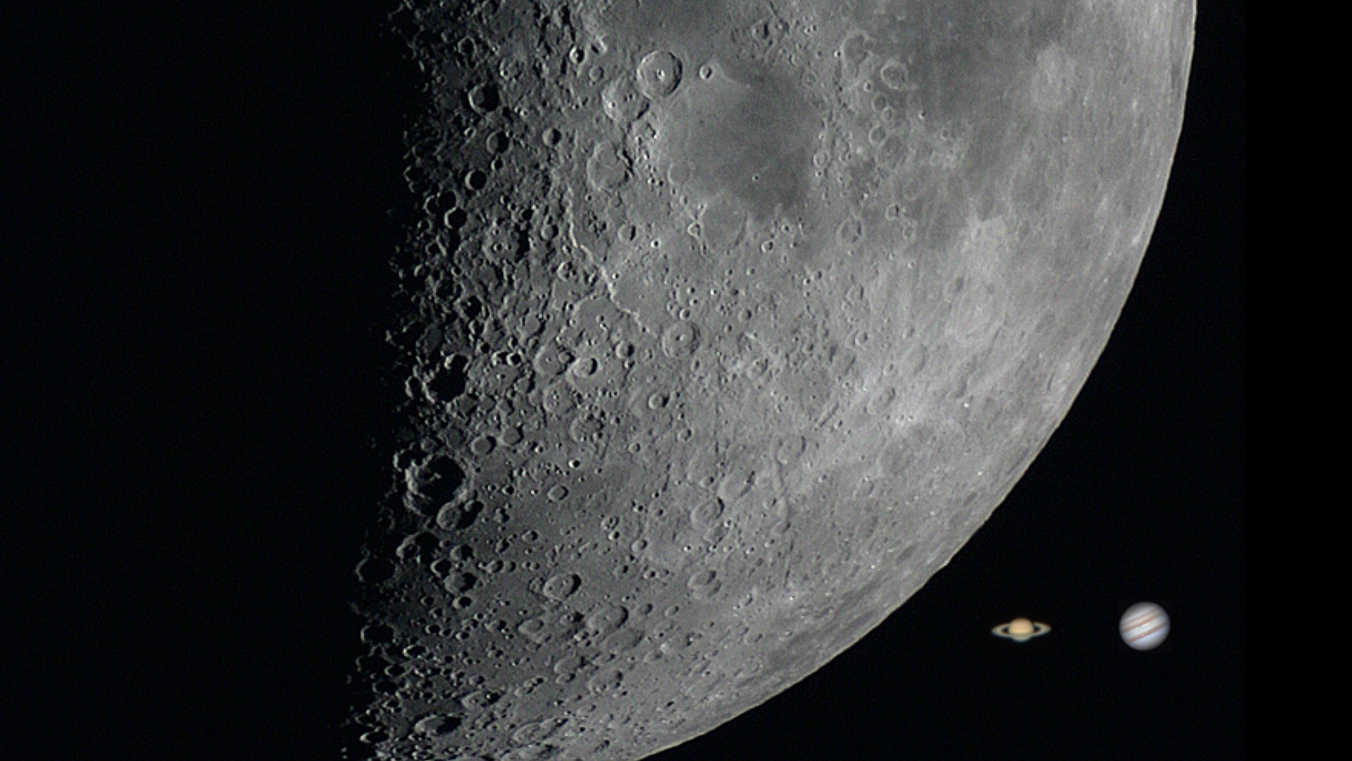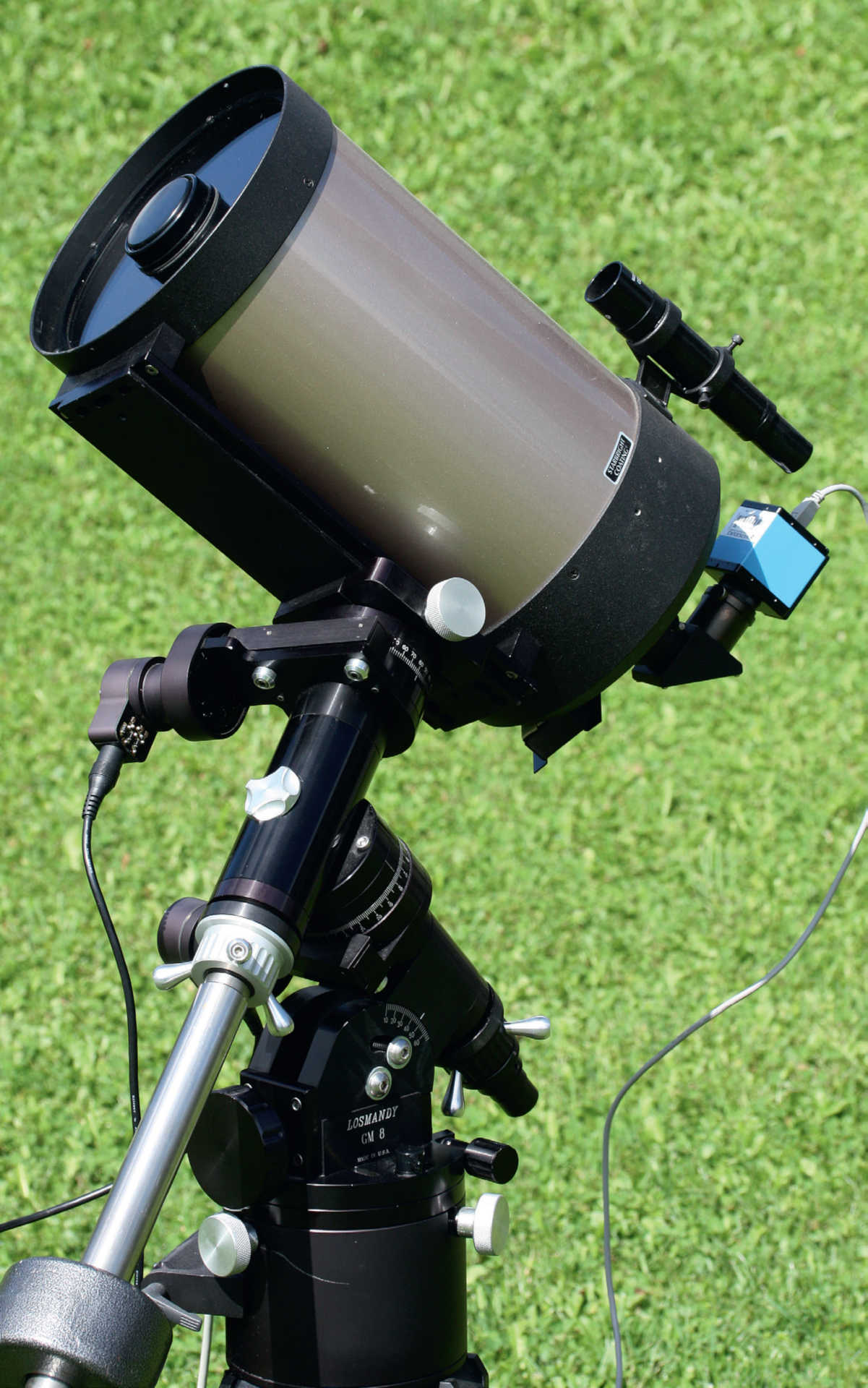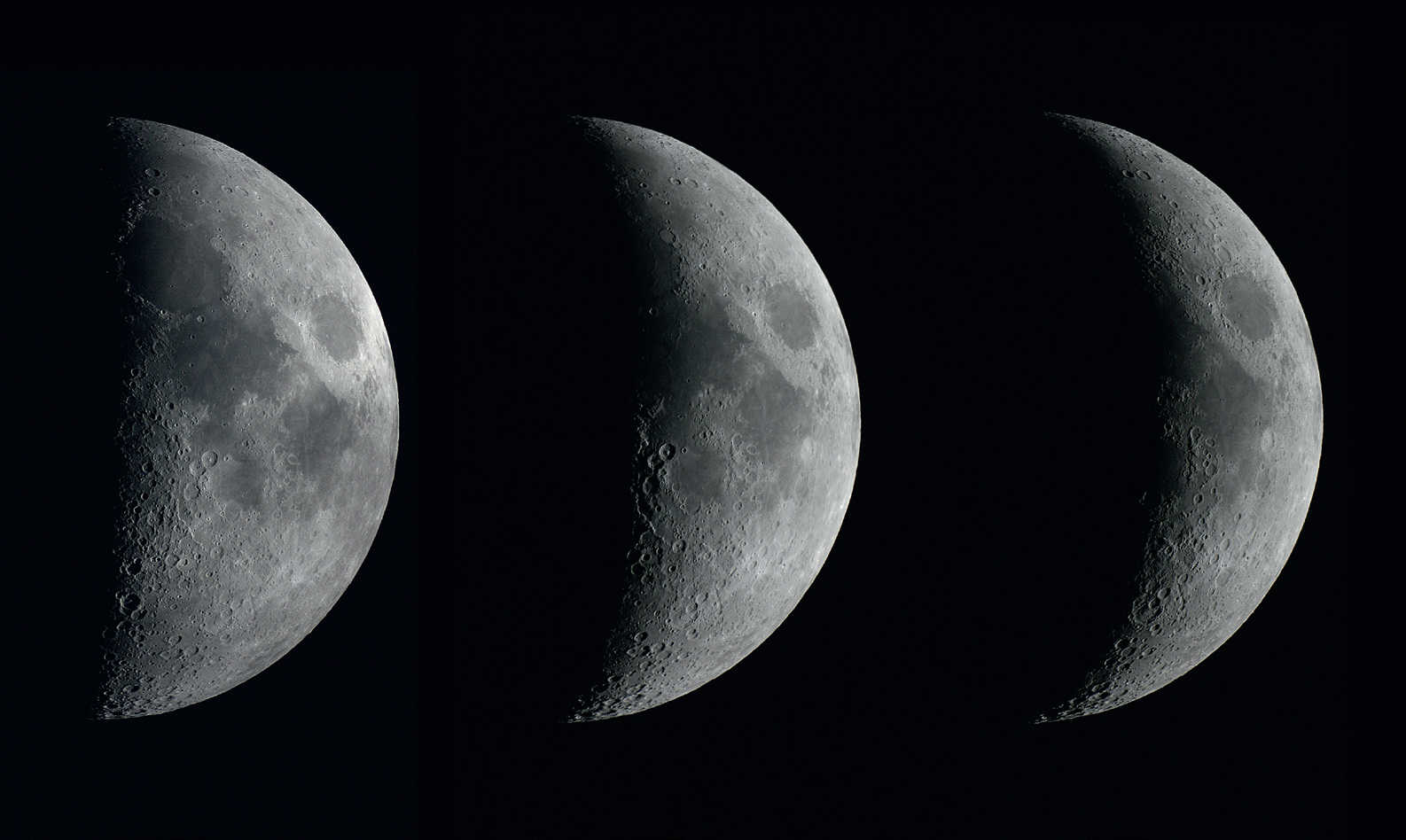The Moon in focus
Our companion is large and bright: the perfect preconditions for great photos. However, there are a few things to keep in mind. But what are they?
 The relative sizes of the Moon and planets: here you can see the partly-illuminated Moon, which reaches a diameter of around 0.5° in the night sky. Next to it is Jupiter, the largest planet in the solar system, which has an angular diameter of 30" to 45", as well as the ringed planet Saturn. U. Dittler
The relative sizes of the Moon and planets: here you can see the partly-illuminated Moon, which reaches a diameter of around 0.5° in the night sky. Next to it is Jupiter, the largest planet in the solar system, which has an angular diameter of 30" to 45", as well as the ringed planet Saturn. U. DittlerAn easy introduction to lunar photography
The Moon can be an exciting and impactful object as an introduction to astrophotography for amateur astronomers. Thanks to modern technology, images can be created in a quality that even professional astronomers could not have managed as recently as 20 years ago.
 As an introduction to lunar photography, a Schmidt Cassegrain telescope on a motor-guided mount is often used (here a Celestron C8 SCT on a Losmandy GM8 mount). The imaging device is an uncooled CCD camera from The Imaging Source. U. Dittler
As an introduction to lunar photography, a Schmidt Cassegrain telescope on a motor-guided mount is often used (here a Celestron C8 SCT on a Losmandy GM8 mount). The imaging device is an uncooled CCD camera from The Imaging Source. U. DittlerWhen choosing a camera to photograph the Moon, it is important that it is able to capture hundreds or thousands of images as a video. Uncooled, low-cost CCD cameras with a monochrome chip have proven themselves here. While telescope focal lengths of around 500 mm (depending on chip size) are sufficient for the creation of images of the entire Moon, significantly longer focal lengths are required for the photography of details such as lunar maria, crater regions or individual craters: often focal lengths between 10,000 mm and 2,500 mm are used for this purpose.
Schmidt-Cassegrain telescopes have proven themselves in lunar photography because of their manageable combination of focal length and light-gathering capabilities. To photograph the Moon, the telescope/camera combination should also be carried and tracked by a stable mount which compensates for the rotation of the Earth.
A variety of subjects
If you want to photograph the individual phases of the Moon over an entire cycle from New Moon to New Moon, besides being prepared to get up early in the morning to capture the images of the narrow crescent of the waning Moon, you’ll also need a telescope with a focal length of up to about 500 mm in order to capture the entire Moon on the small chip of a CCD camera.
When you look at the surface of the Moon through a telephoto lens or telescope, different structures become immediately apparent: a characteristic of the lunar surface are the so-called seas or maria, which have been created by massive meteor impacts. Documenting the maria in varying lighting conditions during the course of a month is an exciting challenge for astrophotographers – more than 30,000 craters with a diameter of one kilometre or more can be counted on the side of the Moon that faces Earth.
Capturing images on the night
The Moon should be photographed at its highest possible point above the horizon in order to reduce the negative influence of haze at the horizon. The correct exposure time for lunar photography depends on several factors such as the telescope aperture, the focal length used, the sensitivity of the camera chip and, of course, the local conditions. However, the exposure times are always in the range of fractions of a second and can be easily controlled with your camera’s image histogram function: the peak in your camera’s histogram display must not lie too far to one side or be cut off. Depending on the conditions, several hundred or several thousand images should be captured and saved as a video sequence in the highest possible quality.
 The phases of the waxing Moon over three consecutive days. The exposures were taken a day apart with a Canon 450D DSLR using a refractor with a 102 mm aperture and a focal length of 1,000 mm. U. Dittler
The phases of the waxing Moon over three consecutive days. The exposures were taken a day apart with a Canon 450D DSLR using a refractor with a 102 mm aperture and a focal length of 1,000 mm. U. DittlerPractical tips
Checklist for lunar photography
• Before the start of the night, your telescope should be placed outside in the shade in order to cool down completely
• An observation site away from built-up areas should be chosen to reduce the negative effects of light pollution and heat radiation
• Set up the mount and roughly align using a compass
• Attach the telescope and camera
• Balance the mount
• Connect the camera and notebook to the power supply, connect the camera to the notebook
• Start the image acquisition software on the notebook, configure the imaging folder and imaging parameters
• Start motorised tracking
• Focus the camera carefully
• Set the exposure time (in doing so, pay attention to the histogram)
• Start the series of exposures
Sharper images
 View of the craters Theophilus, Cyrillus and Catharina. Photographed on 16 September 2014 with an uncooled CCD camera on a SCT with 280 m aperture, focal length reduced to 1,960 mm with a focal reducer. The composite picture was created from 500 exposures from a sequence of 2,500. U. Dittler
View of the craters Theophilus, Cyrillus and Catharina. Photographed on 16 September 2014 with an uncooled CCD camera on a SCT with 280 m aperture, focal length reduced to 1,960 mm with a focal reducer. The composite picture was created from 500 exposures from a sequence of 2,500. U. DittlerLater on in the digital imaging processing, the sharpest images are processed into a composite picture. In this way, not only can atmospheric turbulence be eliminated from the images, but also camera noise can be reduced. Which data format is selected depends on the software used. The SER format which supports, for example, Lucam Recorder software from Heiko Wilkens, Genika Astro from AiryLab, and FireCapture from Torsten Edelmann, has proved its worth.
Various programs are available for image processing: Autostakkert!2 freeware, for example, is very good for developing photographs of the Moon. The program is very clearly structured and self-explanatory: you will very quickly be able to create impressive photographs of the Moon!
Author: Ullrich Dittler / Licence: Oculum-Verlag GmbH
